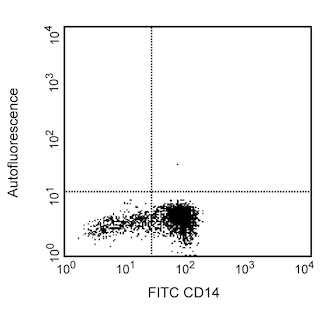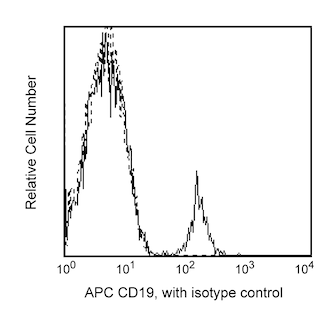-
Your selected country is
Middle East / Africa
- Change country/language
Old Browser
This page has been recently translated and is available in French now.
Looks like you're visiting us from {countryName}.
Would you like to stay on the current country site or be switched to your country?


.png)

Flow cytometric analysis of FCRL5 (CD307e) expression on transfectants and tonsillar B cells. Left Plot: Non-transfected (Dotted line histogram) and Human FCRL5-transfected (Solid line histogram) P815 cells were surface stained with PE Mouse Anti-Human FCRL5 (CD307e) (Cat. No. 566734) at 0.5 µg/test. Flow cytometric fluorescence histograms showing the expression of FCRL5 (CD307e) on non-transfected or Human FCRL5-transfected P815 cells were derived from gated events with the forward and side light-scatter characteristics of viable cells. Flow cytometry and data analysis were performed using a BD LSRFortessa™ Cell Analyzer System and FlowJo™ software. Middle and Right Plots: Tonsil cells were treated with an Fc receptor blocker and stained with APC Mouse Anti-Human CD19 (Cat. No. 561742 or 555415) and either PE Mouse Anti-Human FCRL5 (CD307e) (Cat. No. 566734; Middle Plot) or PE Mouse IgG2a, κ Isotype Control (Cat. No. 554648; Right Plot). Two-color flow cytometric dot plots show the correlated expression patterns of FCRL5 (CD307e) [or Ig isotype control staining] versus Human CD19 for gated events with the forward and side light-scatter characteristics of viable lymphocytes. Flow cytometry and data analysis were performed using a BD FACSCalibur™ Flow Cytometer System and FlowJo™ software. Data courtesy of Dr. Marco Colonna, Washington University School of Medicine. Data shown on this Technical Data Sheet are not lot specific.
.png)

BD Pharmingen™ PE Mouse Anti-Human FCRL5 (CD307e)
.png)
Regulatory Status Legend
Any use of products other than the permitted use without the express written authorization of Becton, Dickinson and Company is strictly prohibited.
Preparation And Storage
Product Notices
- Since applications vary, each investigator should titrate the reagent to obtain optimal results.
- An isotype control should be used at the same concentration as the antibody of interest.
- Caution: Sodium azide yields highly toxic hydrazoic acid under acidic conditions. Dilute azide compounds in running water before discarding to avoid accumulation of potentially explosive deposits in plumbing.
- For fluorochrome spectra and suitable instrument settings, please refer to our Multicolor Flow Cytometry web page at www.bdbiosciences.com/colors.
- Please refer to www.bdbiosciences.com/us/s/resources for technical protocols.
Companion Products





The 509F6 monoclonal antibody specifically binds to Fc receptor-like 5 (FCLR5), a type I transmembrane glycoprotein that is also known as CD307e, FCRH5 (Fc receptor homolog 5) and IRTA2 (immunoglobulin superfamily receptor translocation associated 2). FCRL5 (CD307e) is a member of the Immunoglobulin (Ig) gene superfamily with 9 extracellular Ig domains, an intracellular immunoreceptor tyrosine-based activating motif (ITAM)-like sequence and two intracellular immunoreceptor tyrosine-based inhibitory motif (ITIM)-like sequences. Like other Fc receptor-like proteins, FCRL5 (CD307e) is homologous to FcγR1 (CD64) and binds to immunoglobulins, specifically the IgG isotypes, and it may play a role in the regulatory interactions of immune complexes with B lymphocytes. FCRL5 (CD307e) is differentially expressed in the B cell lineage, with little expression on peripheral blood cells and upregulated expression on plasma cells and some leukemias and lymphomas. mAb 509F6 binds to an epitope within the first 3 Ig domains of FCRL5 and blocks FCRL5's interaction with immune complexes.

Development References (5)
-
Damdinsuren B, Dement-Brown J, Li H, Tolnay M. B cell receptor induced Fc receptor-like 5 expression is mediated by multiple signaling pathways converging on NF-κB and NFAT. Mol Immunol. 2016; 73:112-21. (Clone-specific: Flow cytometry). View Reference
-
Li FJ, Won WJ, Becker EJ, et al. Emerging roles for the FCRL family members in lymphocyte biology and disease.. Curr Top Microbiol Immunol. 2014; 382:29-50. (Biology). View Reference
-
Li H, Borrego F, Nagata S, Tolnay M. Fc Receptor-like 5 Expression Distinguishes Two Distinct Subsets of Human Circulating Tissue-like Memory B Cells. J Immunol. 2016; 196(10):4064-74. (Clone-specific: Flow cytometry). View Reference
-
Polson AG, Zheng B, Elkins K, et al. Expression pattern of the human FcRH/IRTA receptors in normal tissue and in B-chronic lymphocytic leukemia. Int Immunol. 2006; 18(9):1363-1373. (Biology). View Reference
-
Wilson TJ, Fuchs A, Colonna M. Cutting edge: human FcRL4 and FcRL5 are receptors for IgA and IgG. J Immunol. 2012; 188(10):4741-4745. (Immunogen: Blocking, Flow cytometry). View Reference
Please refer to Support Documents for Quality Certificates
Global - Refer to manufacturer's instructions for use and related User Manuals and Technical data sheets before using this products as described
Comparisons, where applicable, are made against older BD Technology, manual methods or are general performance claims. Comparisons are not made against non-BD technologies, unless otherwise noted.
For Research Use Only. Not for use in diagnostic or therapeutic procedures.
Report a Site Issue
This form is intended to help us improve our website experience. For other support, please visit our Contact Us page.